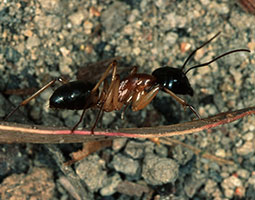Camponotus consobrinus
Description

The banded sugar ant, commonly referred to as a sugar ant, is a native Australian species. Found in open forest, woodland and parks, they are a common sight in Brisbane backyards, ranging from Atherton Tablelands in Queensland down to Tasmania.
They grow to a length of 5-15mm, with workers ranging in size even within the same nest. The head is black; thorax, base of abdomen and legs are orange and there is usually an orange band across their mostly black abdomen.
Banded sugar ants nest in soil in open ground or hidden under rocks and logs. The nest is characterised by a raised ring of loose soil. Workers are nocturnal (active at night) and do not sting, but can deliver a painful bite, exacerbated by a spray of formic acid from their abdomen.
Banded sugar ants are omnivores and feed on sweet substances, tending plant-eating insects such as aphids, feeding on the fluids they secrete. They also act as pollinators of Eucalyptus through nectar collection.
Adaptations
- Large mandibles (pair of appendages near the insect's mouth) to defend themselves and their nest, also for collecting food and nest building materials
- Cannot sting but spray formic acid from a small circular hole (the acidopore) at the tip of the abdomen into a wound inflicted by their mandibles, or to deter predators
Feeding relationships
- What I eat: nectar and other secretions from plants, as well as honeydew from aphids and other plant-eating invertebrates such as caterpillars
- What eats me: echidnas, birds and other ants
Interesting facts
Sugar Ants tend aphids much like farmers tend their stock, moving them around and protecting them from predators.